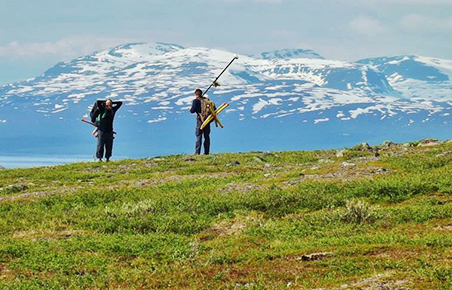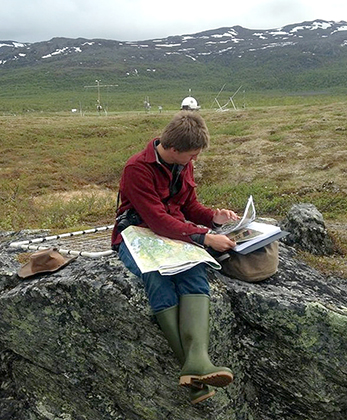Winter/Spring 2016
Earth Systems Science
RUTH VARNER has had a long, rich history of mentoring undergraduates at the Earth Systems Research Center and department of Earth sciences. She was recently recognized for this by the American Geophysical Union, which officially bestowed Varner with the 2015 Sulzman Award for Excellence in Education and Mentoring at the AGU Fall Meeting in San Francisco.
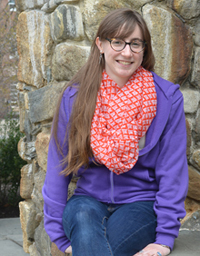 |
|
| Sophie Burke Photo by Kristi Donahue, UNH-EOS. |
But many of those who have been mentored by Varner in the past—in particular the young women who have gone on to get master’s degrees under her tutelage—have honored her less formally by noting they were swept up in the “Varner vortex” as they set their sights on scientific research careers.
Notes Sophie Burke, one of Varner’s mentees and research assistants and now a Fulbright Scholar and Ph.D. student, “Ruth is a very special mentor, her enthusiasm for her research is infectious and she is so genuine in her desire to help her students succeed. I have always admired and appreciated her ability to treat everyone as a colleague whether they are an undergraduate student on their first research experience or a professor participating in a project. To her, everyone brings their experiences to the table.”
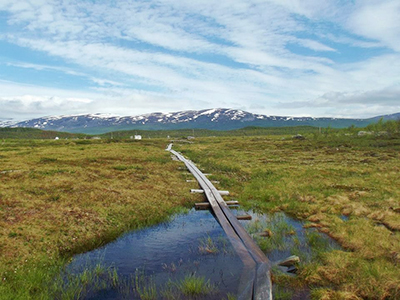 |
|
| The boardwalk through the Stordalen Mire Nature Preserve in Abisko, Sweden. Part of it has sunken into a thaw pond due to thawing permafrost. Photo by Jessica DelGreco, UNH-EOS. |
No effort is more representative of Varner’s mentoring than the NSF-funded Northern Ecosystems Research for Undergraduates (NERU) program, for which she is the founding director. NERU, a collaboration between UNH and the Abisko Scientific Research Station in Abisko, Sweden, focuses on the impacts of climate change on permafrost and lake environments in the Stordalen mire complex some 124 miles north of the Arctic Circle. A specific focus of the research has been measuring methane—a potent greenhouse gas—emissions by various means.
After four years, the program has given 37 undergraduates from colleges around the nation the opportunity to cut their teeth on state-of-the-art climate change field research abroad and in laboratories here at UNH. Students typically come from colleges and universities that lack extensive research programs and opportunities.
One of the key benefits for these undergraduates is having the opportunity to present their findings at the American Geophysical Union’s annual Fall Meeting in San Francisco where 20,000-plus scientists gather to share the latest findings in geophysical research. But in order to participate, the NERU students must prepare their abstracts for submission shortly after their return from Sweden and just two days before the summer program ends.
Says Varner, “They have to have really synthesized their work by the end of this intensive program and be able to write a coherent, professional scientific abstract about their research project, and it’s really us—me as the director and the mentors working with the students—looking over their whole body of work from ten weeks to make sure it makes sense.” Of the AGU meeting Varner adds, “It’s an opportunity for them to network and think about graduate schools, meet potential advisors or look for jobs. Not too many undergraduates have that kind of opportunity.”
Joining Varner this past summer as part of the mentoring crew were Erik Hobbie, Michael Palace, and Carrie McCalley of EOS, Joel Johnson of the department of Earth science, high school teacher Alison Hobbie, and graduate student Natalie Kashi. The 2015 contingent of NERU students included: Jessica DelGreco, UNH; Christopher Horrultiner, University of Florida; Erin Marek, Transylvania University; Kellen McArthur, University of Minnesota; Adam Nicastro, Miami University of Ohio; Clarice Perryman, Earlham College; and Melissa Schwan, University of Arizona.
Kellen McArthur and Erin Marek are two of the seven 2015 NERU fellows. McArthur is a geology major from the University of Minnesota-Morris and Marek is a biology major from Transylvania University. Upon their return from the four weeks studying at the Abisko Scientific Research Station—and squeezed in between finalizing their data for a final poster session and submission of abstracts for the 2015 Fall AGU meeting—they provided Spheres with a brief summation of their summer NERU experience and how it influenced their future plans.
McArthur’s research project in the Stordalen Mire consisted of extracting “pore” water from 20 centimeters beneath the peatland/permafrost surface to see what kind of correlation there is between the cover vegetation and the type of process microbes belowground are using to make methane. The NERU experience was McArthur’s very first foray into research.
“It was a great experience, an amazing opportunity,” McArthur says. “To be funded to do research and be able to see if this is the path you want to follow and make all these connections for graduate school is invaluable. Simply can’t put a price on it.”
He adds, “That said, it was frustrating at times and always challenging because things never work quite the way you planned. You have to be able to think on your feet, adapt, and stay calm and not freak out when things go completely south. Being able to shift gears and find a new game plan and overcome those challenges was probably the most rewarding part of the field experience for me—and being able to figure things out on my own.”
He says the Abisko venture was a “solidifying experience” with respect to his future plans. “I learned that I like research and being in the field a lot and like having a specific project to work on. I learned I could be very happy doing that exact thing and this will help guide me in terms of my plans for graduate school.”
Marek’s work in Abisko investigated how soil microbial activity might be playing a role in the expansion of shrubs into open areas or heath systems.
“Shrub expansion is a really hot topic because, essentially, they are expanding and releasing more carbon dioxide to the atmosphere so it’s a positive feedback system that could potentially escalate global warming but it’s still not very well understood.”
Of the experience she adds, “What was really surprising was the sheer amount of work we had to do. There were days when I’d wake up at 8 a.m., be out in the field for six to seven hours, and come back and have to do lab work till one or two in the morning. And that wasn’t a rarity, it was most days and we were working seven days a week for four weeks.”
Marek has known for some time that she wants to go to graduate school but wasn’t sure what type of research she wanted to focus on (her undergraduate focus is an eclectic mix of animal behavior, ecology and evolution and a second major in art history). Post-Abisko, Marek says, “I like the mix of lab and field work a lot, I like the fact that the overarching theme of this summer’s research—climate change—is a critical area of research. So I think I’m going to be looking at graduate schools that offer biogeochemistry as a program and looking for labs that might allow me to continue some of the research I did here.”
Varner notes that she was particularly impressed this past summer by how much the students helped each other even when their projects did not necessarily overlap.
For example, students like Marek had field samples they had to process in a timely fashion “and might have to stay up till early morning to get the job done and they’d all help out, even the ones who were working on totally different projects. And this was stuff that was boring and repetitive but they wanted to help each other out. That was really nice to see,” Varner says.
And four years and 37 students later, Varner says it’s also very nice to know that the NERU program has been very successful in creating a diverse group of students who are getting an international research experience that would never be possible at their home institutions. The students who have gone through the program have been 63 percent female, 21 percent from underrepresented groups and included a number of non-traditional students.
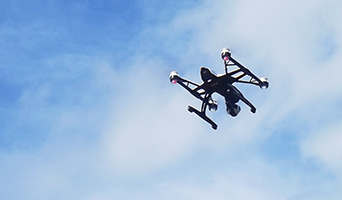 |
|
| Mike Palace's airborne drone. Photo by Mike Palace, UNH-EOS. |
“It’s been really valuable having a diverse group of students in terms of gender, ethnicity, age and experiences. To me, that’s made for great group dynamics, they learn a lot from each other,” Varner says. “The NSF REU program emphasizes a commitment to recruiting students from teaching-focused institutions and recruiting students that are under represented in the discipline.”
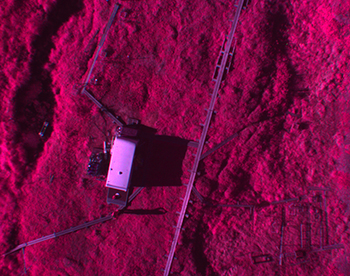 |
|
| Drone image taken in near infrared, red, and green bands—the same bands as the Landsat satellite. Photo by Mike Palace, UNH-EOS. |
And what has been learned scientifically after four years?
“I think what we’ve been able to understand, especially working with Mike Palace and his drones or unmanned aerial vehicles, is how fast the system is changing,” Varner says. “We’ve observed really significant changes in the amount of vegetation cover. We’ve observed the system thawing and getting wetter over the last four years using the UAVs and also our measurements of emissions. So we’re mapping the vegetation but also measuring emissions of methane from different vegetation types. And since we’ve collected these data for several years now we can look at the variability year to year, and begin to publish.”
